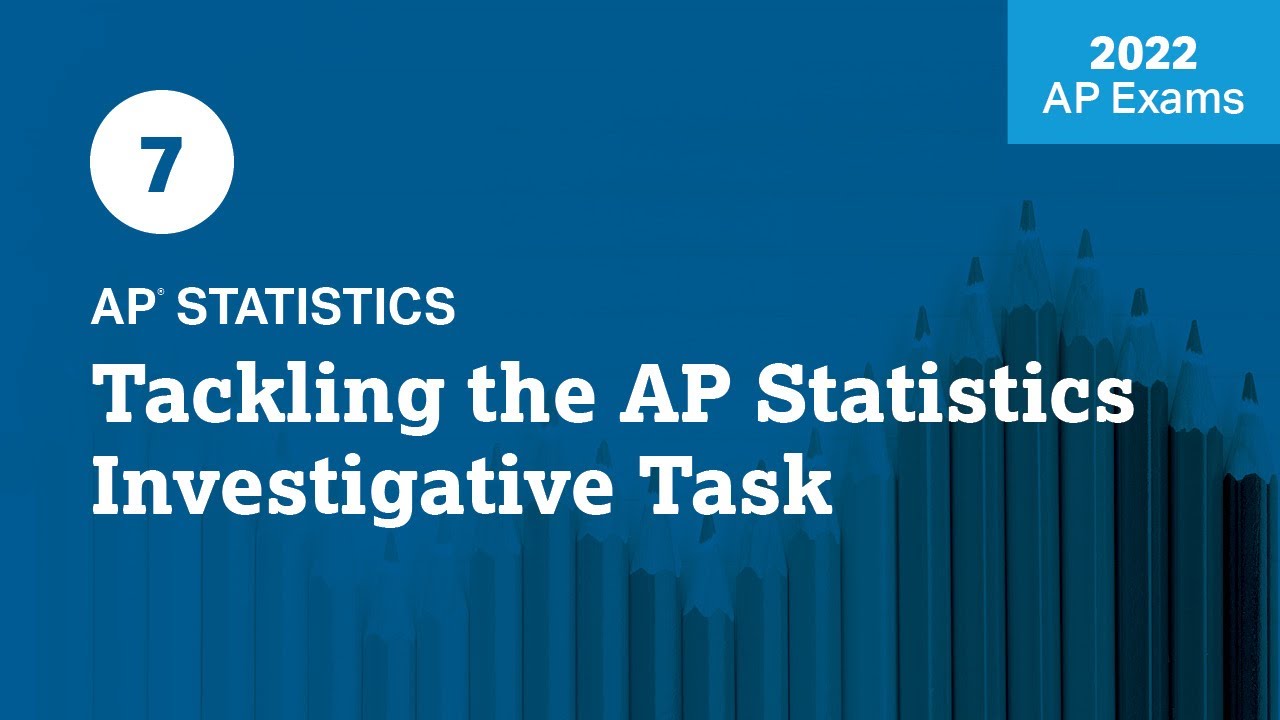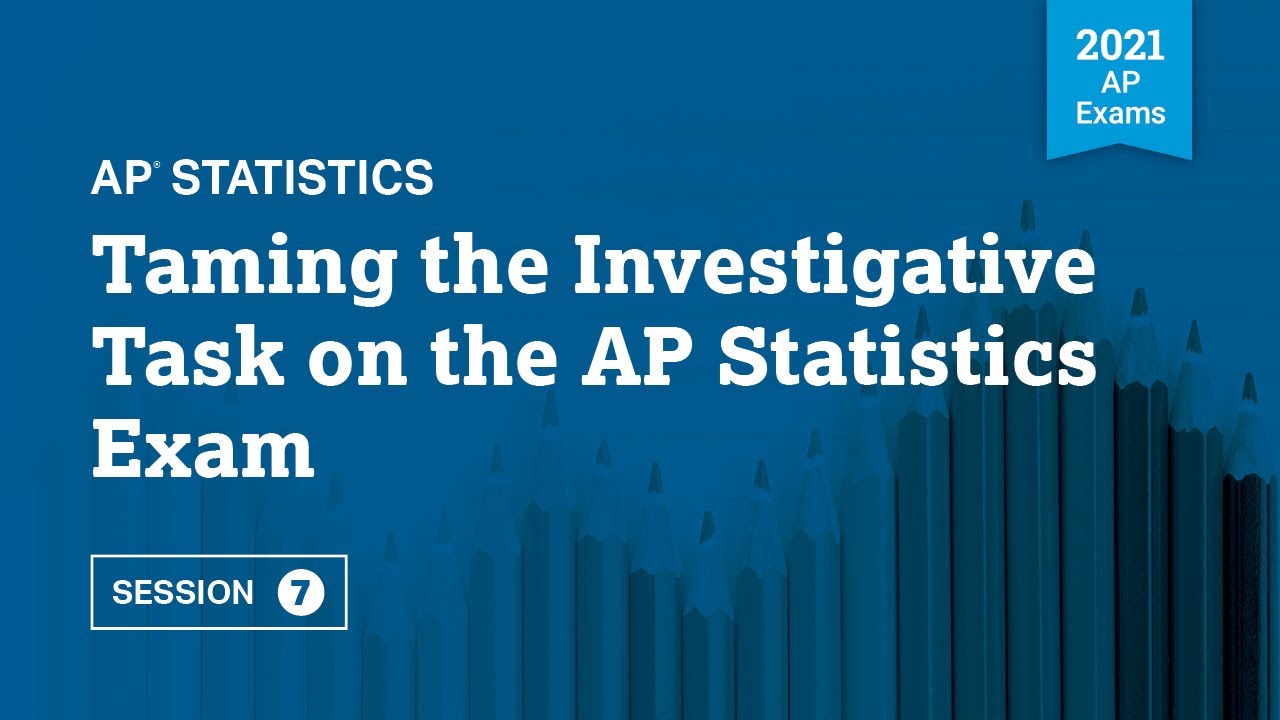7 | FRQ (Part B, Question 6: Investigative Task) | Practice Sessions | AP Statistics
TLDRIn this AP Stats practice session, Mr. Starnes guides students through an investigative task involving a scatterplot of house sizes and selling prices. He explains how to describe the data's association, construct a segmented bar graph from a two-way table, and calculate expected values assuming no association. The session also explores the impact of altering a data point on the correlation coefficient (r) and chi-square statistic, highlighting the strengths and limitations of each in measuring association. This comprehensive review prepares students for the AP exam's investigative tasks.
Takeaways
- 📚 Mr. Starnes introduces the AP Daily Practice Session for AP Stats students, focusing on the investigative task in the free response section.
- 🔍 Students are encouraged to download the questions and try them before watching the solutions to enhance their learning experience.
- 📈 The first task involves describing the association in a scatterplot showing the relationship between house size and selling price, highlighting the importance of direction, form, strength, unusual features, and context.
- 📊 Mr. Starnes provides a model response for describing the scatterplot, emphasizing the strong positive linear association and the presence of an unusual point.
- 🏠 Part b(i) of the task requires students to construct a graphical display using a two-way table categorizing houses as large or not-large and expensive or not-expensive.
- 📊 For part b(ii), students are asked to complete a table with expected numbers of houses for each classification assuming no association between size and price, using overall percentages.
- 🤔 In part c(i), the effect of changing the selling price of the most expensive house on the correlation coefficient (r) is discussed, noting that it would weaken the linear relationship.
- 📉 Similarly, part c(ii) explores the impact of the same price change on the chi-square statistic, concluding that it remains unaffected since the house's category does not change.
- 📝 The final part, d, invites students to reflect on the benefits and drawbacks of using chi-square versus r to measure the strength of an association, highlighting chi-square's resistance to unusual values and its loss of information about individual data points.
- 🔑 The session concludes with advice for students to practice investigative tasks and make use of additional resources like on-demand review videos in the AP Classroom.
- 👋 Mr. Starnes signs off, expressing hope to see students in the next session, emphasizing the importance of understanding and practicing investigative tasks.
Q & A
What is the main focus of the AP Daily Practice Sessions video?
-The main focus of the video is to guide AP Stats students through the investigative task, which is the final question in the free response section of their exam.
What does Mr. Starnes advise students to do before watching the solutions in the video?
-Mr. Starnes advises students to pause the video, download the questions using the provided link, and try solving the questions on their own before watching the solutions.
What is the first task students are asked to do in the video?
-The first task is to describe the association shown in a scatterplot that displays the size and selling price of 30 houses for sale in a certain area.
What elements should be included in the description of the scatterplot's association?
-The description should include the direction of the relationship (positive or negative), the form of the relationship (linear, for example), the strength of the relationship (strong, moderately strong, etc.), any unusual features in the graph, and the context (names of the variables involved).
How does Mr. Starnes describe the association between size and selling price in the scatterplot?
-Mr. Starnes describes the association as a strong positive linear association with an unusual point near 4,000 square feet and a selling price of almost $500,000.
What is the purpose of constructing a graphical display of the data in part b(i) of the task?
-The purpose is to visually represent the relationship between the size of the houses (large or not-large) and whether they are expensive or not, using the information provided in a two-way table.
What type of graph is used to display the data in part b(i) of the task?
-A segmented bar graph is used to display the data, comparing the large and not-large houses in terms of their relative frequency of being expensive or not.
What is the chi-square statistic used for in the context of the video?
-The chi-square statistic is used to measure the strength of association between two categorical variables, as summarized in a two-way table.
What is the effect of decreasing the selling price of the most expensive house in the sample on the value of r, the correlation coefficient?
-Decreasing the selling price of the most expensive house would weaken the strength of the linear relationship, as the point would no longer fit the linear pattern of the rest of the data, thus causing the correlation coefficient r to decrease.
How does the chi-square statistic respond to the decrease in the selling price of the most expensive house, as described in part c(ii) of the task?
-The chi-square statistic remains unchanged because the house still falls into the same category of large and expensive in the two-way table, and thus the observed and expected counts do not change.
What is one benefit and one drawback of using chi-square rather than r to measure the strength of an association, as discussed in part d of the task?
-One benefit of using chi-square is that it is resistant to unusual values, meaning that one unusual point does not overly influence the statistic. A drawback is that chi-square treats all expensive or large houses the same, potentially losing some information about the strength of the relationship, unlike r, which is more sensitive to changes in individual data points.
Outlines
📊 AP Stats Practice: Investigative Task Overview
Mr. Starnes introduces an AP Daily Practice Session focusing on the investigative task in AP Stats. He encourages students to download the questions and attempt them before watching the solutions. The session begins with a scatterplot analysis of house sizes and selling prices, highlighting the need to describe the association, direction, form, strength, and any unusual points. A model response is provided to exemplify a correct approach. The instructor also guides students through constructing a segmented bar graph from a two-way table, emphasizing the importance of labeling and scaling axes correctly.
📈 Analyzing Data Relationships and Graphical Displays
This section delves into the analysis of the relationship between house size and selling price, using both scatterplots and two-way tables. Mr. Starnes explains how to construct a graphical display from categorical data, detailing the process of creating a segmented bar graph to compare large and not-large houses in terms of their selling price. He also discusses the chi-square statistic as a measure of association for categorical data, contrasting it with the correlation coefficient r used for quantitative data. The impact of altering the selling price of a house on both r and the chi-square statistic is explored, illustrating the different sensitivities of these measures to data changes.
🔍 Reflecting on Statistical Measures: Chi-Square vs. Correlation Coefficient
The final part of the script invites students to reflect on the investigative task, considering the benefits and drawbacks of using chi-square versus the correlation coefficient to measure the strength of an association. The instructor points out that while chi-square is resistant to the influence of unusual values, it may not capture significant changes in individual data points, unlike the correlation coefficient. This reflective exercise aims to deepen students' understanding of statistical analysis and its applications in real-world scenarios.
Mindmap
Keywords
💡AP Stats
💡Scatterplot
💡Association
💡Linear Association
💡Chi-square Statistic
💡Correlation Coefficient (r)
💡Two-way Table
💡Relative Frequency
💡Segmented Bar Graph
💡Investigative Task
💡Categorical Data
Highlights
Introduction to AP Daily Practice Sessions with Mr. Starnes.
Emphasis on trying questions before watching solutions.
Explanation of the investigative task in the free response section.
Description of how to describe the association in a scatterplot.
Model response for describing a strong positive linear association.
Importance of including context when describing associations.
Instructions for constructing a graphical display from a two-way table.
Guidance on creating a segmented bar graph for categorical data.
Explanation of how to calculate and interpret the chi-square statistic.
Impact of changing the selling price on the correlation coefficient.
Analysis of the effect of price change on the chi-square statistic.
Discussion on the benefits of using chi-square over r for measuring association.
Consideration of drawbacks when using chi-square compared to r.
Encouragement to practice investigative tasks for AP Stats.
Recommendation to use AP Classroom for additional review and practice.
Invitation to the next session focusing on another investigative task.
Summary of the session structure and the importance of understanding investigative tasks.
Transcripts
Browse More Related Video

8 | FRQ (Part B, Question 6: Investigative Task) | Practice Sessions | AP Statistics

5 | MCQ | Practice Sessions | AP Statistics

2022 Live Review 7 | AP Statistics | Tackling the AP Statistics Investigative Task

2021 Live Review 7 | AP Statistics | Taming the Investigative Task on the AP Statistics Exam

Elementary Stats Lesson #6

Correlation and Regression Analysis: Learn Everything With Examples
5.0 / 5 (0 votes)
Thanks for rating: